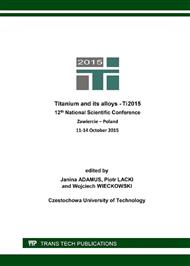[1]
Information on http: /www. twi-global. com.
Google Scholar
[2]
R.S. Mishra, Preface to the Viewpoint Set on friction stir processing, Scripta Mater. 58 (2008) 325–326.
DOI: 10.1016/j.scriptamat.2007.10.044
Google Scholar
[3]
G. Buffa, J. Hua, R. Shivpuri, L. Fratini, A continuum based fem model for friction stir welding—model development, Mater. Sci. Eng. A 419 (2006) 389–396.
DOI: 10.1016/j.msea.2005.09.040
Google Scholar
[4]
C.M. Chen, R. Kovacevic, Parametric finite element analysis of stress evolution during friction stir welding, Proc. IMechE Vol. 220 (2006) Part B: J. Eng. Manuf., 1359-1371.
DOI: 10.1243/09544054jem324
Google Scholar
[5]
P. Lacki, Z. Kucharczyk, R.E. Śliwa, T. Gałaczyński, Effect of tool shape on temperature field in friction stir spot welding, Arch. Metall. Mater. 58/2 (2013) 597-601.
DOI: 10.2478/amm-2013-0043
Google Scholar
[6]
P.A. Colegrove, H. R. Shercliff, 3-Dimensional CFD modelling of flow round a threaded friction stir welding tool profile, J. Mater. Process. Technol. 169 (2005) 320–327.
DOI: 10.1016/j.jmatprotec.2005.03.015
Google Scholar
[7]
R. Nandan, G.G. Roy, T.J. Lienert, T. DebRoy, Numerical modelling of 3D plastic flow and heat transfer during friction stir welding of stainless steel, Sci. Technol. Weld. Join. 11 (2006) 526-537.
DOI: 10.1179/174329306x107692
Google Scholar
[8]
H.W. Zhang, Z. Zhang, J.T. Chen, The finite element simulation of the friction stir welding process, Mater. Sci. Eng. A 403 (2005) 340–348.
DOI: 10.1016/j.msea.2005.05.052
Google Scholar
[9]
H.W. Zhang, Z. Zhang, J.T. Chen, 3D modeling of material flow in friction stir welding under different process parameters, J. Mater. Process. Technol. 183 (2007) 62–70.
DOI: 10.1016/j.jmatprotec.2007.06.042
Google Scholar
[10]
M. Esmaily, A. Shokuhfar, Numerical simulation of heat transfer in friction stir welding of 7075-T6 aluminum alloy and high carbon steel using Arbitrary Lagrangian Eulerian technique, Mat. -wiss. u. Werkstofftech. 41 (2010) 350-355.
DOI: 10.1002/mawe.201000608
Google Scholar
[11]
M. Song, R. Kovacevic, Thermal modeling of friction stir welding in a moving coordinate system and its validation, Int. J. Mach. Tools Manuf. 43 (2003) 605–615.
DOI: 10.1016/s0890-6955(03)00022-1
Google Scholar
[12]
S. Hirasawa, H. Badarinarayan, K. Okamoto, T. Tomimura, T. Kawanami, Analysis of effect of tool geometry on plastic flow during friction stir spot welding using particle method, J. Mater. Process. Technol. 210 (2010) 1455–1463.
DOI: 10.1016/j.jmatprotec.2010.04.003
Google Scholar
[13]
H. Okuyucu, A. Kurt, E. Arcaklioglu, Artificial neural network application to the friction stir welding of aluminum plates, Mater. Des. 28 (2007) 78–84.
DOI: 10.1016/j.matdes.2005.06.003
Google Scholar
[14]
H. Schmidt, J. Hattel, J. Wert, An analytical model for the heat generation in friction stir welding, Modelling Simul. Mater. Sci. Eng. 12 (2004) 143–157.
DOI: 10.1088/0965-0393/12/1/013
Google Scholar
[15]
S. Mandal, J. Rice, A.A. Elmustafa, Experimental and numerical investigation of the plunge stage in friction stir welding, J. Mater. Process. Technol. 203 (2008) 411–419.
DOI: 10.1016/j.jmatprotec.2007.10.067
Google Scholar
[16]
M. Riahi, H. Nazari, Analysis of transient temperature and residual thermal stresses in friction stir welding of aluminum alloy 6061-T6 via numerical simulation, Int. J. Adv. Manuf. Technol. 55 (2011) 143–152.
DOI: 10.1007/s00170-010-3038-z
Google Scholar
[17]
K.J. Colligan, R.S. Mishra, A conceptual model for the process variables related to heat generation in friction stir welding of aluminum, Scripta Mater. 58 (2008) 327–331.
DOI: 10.1016/j.scriptamat.2007.10.015
Google Scholar
[18]
Y.J. Chao, X. Qi, W. Tang, Heat Transfer in Friction Stir Welding—Experimental and Numerical Studies, Trans. ASME, J. Manuf. Sci. Eng. 125 (2003) 138-145.
DOI: 10.1115/1.1537741
Google Scholar
[19]
P. Lacki, Friction modelling in the bulk metal forming processes, Wydawnictwo Politechniki Częstochowskiej, seria Monografie nr 169, Częstochowa 2010 (in Polish).
Google Scholar
[20]
ADINA-AUI, Version 8. 8. 0, 1994-2012 ADINA R&D. Inc.
Google Scholar
[21]
K. Adamus, Z. Kucharczyk, K. Wojsyk, K. Kudla, Numerical analysis of electron beam welding of different grade titanium sheets, Comput. Mater. Sci. 77 (2013) 286–294.
DOI: 10.1016/j.commatsci.2013.05.001
Google Scholar
[22]
J. Adamus, P. Lacki, M. Motyka, EBW titanium sheets as material for drawn parts. Arch. Civ. Mech. Eng. 15/1 (2015) 42–47.
DOI: 10.1016/j.acme.2014.04.004
Google Scholar
[23]
P. Lacki, J. Adamus, W. Więckowski, J. Winowiecka, Evaluation of drawability of titanium welded sheets Arch. Metall. Mater. 58/1 (2013) 139-143.
DOI: 10.2478/v10172-012-0164-7
Google Scholar
[24]
J. Adamus, P. Lacki, Analysis of forming titanium welded blanks. Comp. Mater. Sci. 94 (2014) 66–72.
DOI: 10.1016/j.commatsci.2014.01.055
Google Scholar
[25]
J. Adamus, M. Motyka, Analysis of tensile test of titanium EBW sheet. Key Eng. Mat. 639 (2015) 339-346.
DOI: 10.4028/www.scientific.net/kem.639.339
Google Scholar
[26]
K. Adamus, P. Lacki, The numerical analysis of a titanium sheets welding process and welding joint tensile behavior, Computer Methods in Materials Science 15/1 (2015) 137-143.
Google Scholar
[27]
P. Lacki, K. Adamus, Numerical simulation of welding thin titanium sheets, Key Eng. Mat. 549 (2013) 407-414.
DOI: 10.4028/www.scientific.net/kem.549.407
Google Scholar
[28]
P. Lacki, K. Adamus, P. Wieczorek, Theoretical and experimental analysis of thermo-mechanical phenomena during electron beam welding process, Comp. Mater. Sci. 94 (2014) 17-26.
DOI: 10.1016/j.commatsci.2014.01.027
Google Scholar


